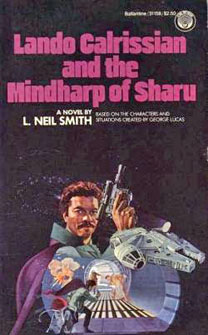I was too young to read the 1970s and ’80s “Star Wars” spinoff novels when they came out, but those seven books sat in my childhood collection just the same. I read “Splinter of the Mind’s Eye” and the “Han Solo Adventures” in high school, but I didn’t get around to the “Lando Calrissian Adventures” until a few years ago. Chronicling a supporting character in yarns that have no impact on any other books, this trilogy struck me as being about as nonessential as “Star Wars” books can get.
On the other hand, it’s the weird, outsider nature of these novels that make them so fascinating — and largely immune to criticism. It takes a die-hard, completist fan to read them in the first place, but to read them is to kind of love them. A recent Star Wars Insider piece (issue 145) made me further appreciate them, because I learned that Del Rey and Lucasfilm asked author L. Neil Smith to crank out this trilogy in just nine weeks (!) in early 1983. The author talked the powers-that-be into letting him use the Millennium Falcon, but everything else from the movies was off limits — no Empire, no Rebellion, no Force, no Han Solo. Smith was also asked to keep politics out of the books, even though his free market/live-and-let-live philosophy (he once ran for president on the Libertarian Party ticket) meshes well with Lando, an entrepreneurial type.
If you’re looking for it, some of Smith’s worldview comes out anyway in “Lando Calrissian and the Mindharp of Sharu.” Lando, whom Smith often dubs “the gambler,” looks to make some money at various sabacc tables in the Centrality, but instead is manipulated by powerful forces, namely the corrupt governor of Rafa IV and Rokur Gepta, a “Sorcerer of Tund” whom Smith originally conceived as a Dark Lord of the Sith before Lucasfilm’s edicts came down.
“Sharu” is an adventure novel, but there aren’t many action-packed scenes. Although Lando has a fair amount of violence done to him, the third-person omniscient narration gives it all a shrugging, just-brush-it-off tone. It’s a “Star Wars” novel, featuring “coffeine” as a beverage of choice and the first appearance of the poker-like card game sabacc (Smith’s biggest contribution to the GFFA), but the author unfortunately uses a lot of Earth words like “cigarette” and “television” and “dinosaur.”
Above all, it’s a sci-fi novel, with a touch of Isaac Asimov in Vuffi Raa, best summed up as a living droid, and a touch of Arthur C. Clarke in the Sharu pyramids of the chilly planet Rafa V. Lando retains a hint of the self-confident ladies man we met in the movies — particularly in his clothing choices (although, somewhat surprisingly, there is no “Bond girl” to be found here) — although he is quicker with a quip. Mostly, he’s a Clarkeian all-purpose protagonist like you’d find in “Rendezvous with Rama.” Interestingly, Lando would again go on a quest through a mysterious spaceship in the “Black Fleet Crisis” trilogy in the 1990s; I wonder if author Michael P. Kube-McDowell was giving a nod to “Sharu.”

Vuffi Raa is Lando’s answer to Chewbacca, Artoo and Threepio in that he’s a pilot and is filled with knowledge. He also looks somewhat like Artoo on the cover painting, although he can morph into various shapes, sprout five tentacles, and self-repair. He’s Lando’s sounding board and, ultimately, his best friend, although Lando sends a lot of pseudo-annoyed banter the droid’s way, namely “Don’t call me Master.” (When Vuffi Raa obliges, Lando says “Don’t call me Lando.”)
We’d later learn — in A.C. Crispin’s “Han Solo Trilogy” in the 1990s — that Lando did know Han during this time. But without that knowledge, and without any backstory for Lando (not even so much as a mention of his home planet, which I know is Socorro only from looking it up on Wookieepedia), the main character comes off as a bit of a loner, and the whole adventure has an air of melancholy, edge-of-the-galaxy loneliness in the way it resists melding with the larger “Star Wars” saga.
Given his incredible constraints, the fact that Smith produces a fun, readable piece of sci-fi pulp is an accomplishment in and of itself. Wouldn’t it be cool, though, if Del Rey invited him back to tell some “Star Wars” stories without wearing binders? We have a trilogy about Han Solo’s youth; we’re long overdue for the story of Lando’s formative years, too.

